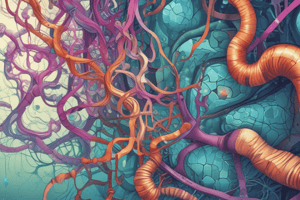Podcast
Questions and Answers
The Law of Segregation states that two factors governing each trait are combined during gamete formation.
The Law of Segregation states that two factors governing each trait are combined during gamete formation.
False (B)
A pea plant with the genotype SSYy is homozygous for both seed texture and seed color.
A pea plant with the genotype SSYy is homozygous for both seed texture and seed color.
False (B)
The phenotype resulting from the genotype SSYy is smooth and yellow.
The phenotype resulting from the genotype SSYy is smooth and yellow.
True (A)
The genotype SsYy will produce a phenotype that is wrinkled and green.
The genotype SsYy will produce a phenotype that is wrinkled and green.
In genetic engineering, the term 'transformation' refers to the uptake of recombinant DNA by a cell.
In genetic engineering, the term 'transformation' refers to the uptake of recombinant DNA by a cell.
The genotype Sy and sY would produce the same phenotype in the parent SsYy.
The genotype Sy and sY would produce the same phenotype in the parent SsYy.
The process of cutting DNA in genetic engineering involves the insertion of a gene into a new piece of DNA.
The process of cutting DNA in genetic engineering involves the insertion of a gene into a new piece of DNA.
Genetic engineering involves the activation of inserted genes to produce their products.
Genetic engineering involves the activation of inserted genes to produce their products.
The allele for yellow (Y) is recessive to the allele for green (y).
The allele for yellow (Y) is recessive to the allele for green (y).
Isolation in genetic engineering is defined as the introduction of base sequence changes in DNA.
Isolation in genetic engineering is defined as the introduction of base sequence changes in DNA.
Flashcards are hidden until you start studying
Study Notes
Species and Variation
- A species is defined as a group of organisms capable of interbreeding and producing fertile offspring.
- Fertility is crucial; interbreeding between closely related species can produce infertile hybrids, such as mules (donkey and horse) and ligers (lion and tiger).
- Variation refers to differences among individuals in a species, encompassing structural traits (e.g., height, weight) and behavioral traits (e.g., aggressiveness).
Heredity and Gene Expression
- Heredity is the transmission of traits from one generation to the next through genes.
- A gene is a sequence of DNA on a chromosome that codes for proteins or influences the development of characteristics.
- Gene expression is the process where information from a gene is used to create a protein or trait, exemplified by brown-eyed individuals having brown-eye genes overpowering blue-eye genes.
Chromosome Structure
- Each gene is located at a specific position known as a locus on a chromosome.
- Genes exist in different forms called alleles, which can be dominant or recessive.
- Chromosomes consist of two strands (chromatids) connected by a centromere and exist as chromatin when spread out, composed of DNA and proteins.
Sex Determination
- In mammals, the presence of XX chromosomes indicates female, while XY indicates male.
- A 50:50 probability exists for offspring being male or female, exemplified by Punnett squares demonstrating gamete combinations.
Incomplete Dominance
- Incomplete dominance is observed in cows, where red and white coat parents produce roan offspring with blended coloring.
- Co-dominance occurs when both parental traits are visible in the offspring.
Dihybrid Crosses
- A dihybrid cross analyzes the inheritance of two traits simultaneously, leading to Mendel's second law of inheritance.
Evolution
- Evolution is the cumulative changes in a species due to adaptation through natural selection over extended periods.
- Evidence for evolution is circumstantial and cannot be definitively proved.
- Charles Darwin and Alfred Russell Wallace proposed the theory of natural selection in 1858, with Darwin publishing "On the Origin of Species" in 1859 after five years of research aboard HMS Beagle.
Theory of Natural Selection
- Observations include overbreeding leading to competition and inherited variations within populations.
- Conclusions emphasize a struggle for existence, survival of the fittest, and resultant diverse offspring over time.
Genetic Concepts
- Sex chromosomes differ between human males (XY) and females (XX), which determine gender.
- Complementary base pairing in DNA involves specific matches of nitrogenous bases (e.g., adenine with thymine).
- Differences between RNA and DNA include RNA being single-stranded, while DNA is double-stranded.
Genetic Engineering
- Genetic engineering is the artificial manipulation of genes involving steps like isolation, cutting, transformation, introduction of base sequence changes, and gene expression.
- Each step contributes to the modification and activation of desired genetic traits through recombinant DNA technology.
Studying That Suits You
Use AI to generate personalized quizzes and flashcards to suit your learning preferences.




